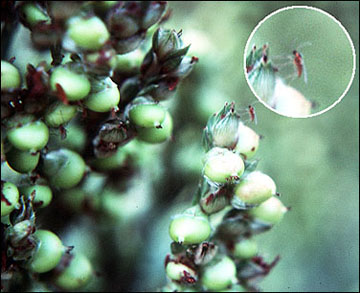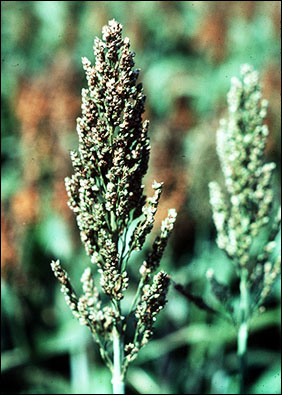The sorghum midge, Contarinia sorghicola (Coquillett), is an important pest of many sorghum species, including grain sorghum, Sorghum bicolor L. Both grain sorghum and johnsongrass, S. halepense (L.) Pers., are its primary host plants. This insect occurs globally and has a wide distribution in the United States from Virginia to Texas.
Description and life cycle
This insect overwinters as larvae within the florets or spikelets (usually in the bottom third) of its host plants. Because the silken cocoons provide protection from cold temperatures and drought, sorghum midge larvae may remain in hibernation for three years. Adults usually emerge in the spring when temperatures reach 68-80 degrees Fahrenheit and johnsongrass is blooming. The adult midge is small (less than 1/8 inch long) with orange coloration and dark wings. Adults rarely live more than two days. After a female has mated, she lays the eggs (30 to 100) within the flowering spikelets or seed husks of the host plant (Figure 1). The larvae (maggots) hatch within two to three days and feed another nine to 11 days before reaching maturity. Generally, the first two generations occur on johnsongrass before midge adults migrate to flowering sorghum heads (yellow anthers exposed on individual spikelets).
 Figure 1
Figure 1
Adult sorghum midge on seed head.
Damage
Sorghum midge larvae feed on the fluids of developing seeds. Normal seed development is inhibited, and infested heads produce small, malformed grain (Figure 2). These damaged heads also appear blasted and pinkish. Generally, early-planted sorghum has less severe infestations, and insecticide applications usually are not needed as with late-planted sorghum. After pollination, the sorghum midge will not cause economic damage.
 Figure 2
Figure 2
Sorghum midge damaged (blasted) seed head.
Scouting procedures and techniques
The best time to scout sorghum fields is during the morning when winds are calm, temperatures are lower, and adults are most active on the flowering heads. Because midge adults are poor flyers, infestations generally start along field borders downwind of alternate host plants. If few midge adults are present in these areas, there is little need to scout the entire field. But, when midge populations approach or surpass the threshold level in the upwind areas, sample 100 seed heads (10 each at 10 locations) per field. Since a new midge brood appears each day during pollination (7-9 days for an individual seed head), fields should be inspected daily. Visual inspection of the whole seed head is the best sampling method. Another method is to place a piece of white cardboard or paper underneath a seed head, vigorously tap it to dislodge the adults, and then count the orange-bodied adults. Unfortunately, this method also can potentially damage the plant.
Economic thresholds
In Missouri, the recommended threshold level for insecticide treatments is one midge per seed head. This threshold level is primarily based on research with susceptible sorghum varieties. In Texas, researchers concluded that threshold levels for resistant varieties could be increased to five adult midges per flowering seed head. This higher threshold is due to the midge's lower egg-laying capacity on these resistant varieties.
Management
Growers can minimize midge damage by planting resistant varieties; however, these varieties are insufficient if sequential plantings permit the season-long buildup of midge populations throughout an area. Depending on a variety of factors (crop development, yield potential and midge density), insecticide use may be needed; however, applications must be timed to target the short-lived adults on the open seed heads (once 50 percent of the heads have emerged from the boot stage).
Precaution
Before you select and apply an insecticide, review the manufacturer's label for information on safe use of the material.
A second application within three to seven days of the first one is necessary if adults are still present in the field (particularly those plants with uneven seedhead development). Because larvae are protected within the seeds or spikelets, insecticides will not affect them. Other management practices include destroying alternate hosts (such as johnsongrass) inside and outside of the field before these hosts flower and produce seed. Once sorghum is harvested, all crop residues should be destroyed.